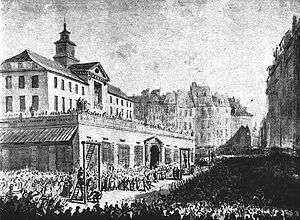Old Town Market Place, Warsaw
| Historic Centre of Warsaw | |
|---|---|
| Name as inscribed on the World Heritage List | |
|
| |
| Type | Cultural |
| Criteria | ii, vi |
| Reference | 30 |
| UNESCO region | Europe and North America |
| Inscription history | |
| Inscription | 1980 (4th Session) |
Warsaw's Old Town Market Place (Polish: Rynek Starego Miasta) is the center and oldest part of the Old Town of Warsaw, capital of Poland. Immediately after the Warsaw Uprising, it was systematically blown up by the German Army.[1] After World War II, the Old Town Market Place was restored to its prewar appearance.
History

The Old Town Market Place is the true heart of the Old Town, and until the end of the 18th century it was the heart of all of Warsaw. It originated in the late 13th century, at the same time that the city was founded.[2] Here the representatives of guilds and merchants met in the town hall (built before 1429, pulled down in 1817), and fairs and the occasional execution were held. The houses around it represented the Gothic style until the great fire of 1607, after which they were rebuilt in late-Renaissance style and eventually in late-Baroque style by Tylman Gamerski in 1701.[3][3][4]
The main feature at that time was the immense town hall, reconstructed in 1580 in the style of Polish mannerism by Antoneo de Ralia and again between 1620-1621.[5] The architecture of the building was similar to many other structures of that type in Poland (e.g. the town hall in Szydłowiec). It was adorned with attics and four side towers. A clock tower, embellished with an arcade loggia, was covered with a bulbous spire typical for Warsaw mannerist architecture (an example being the Royal Castle).[6]
The district was damaged by the bombs of the German Luftwaffe during the Invasion of Poland (1939).[4] The ancient Market Place was rebuilt in the 1950s, after having been destroyed by the German Army after the suppression of the 1944 Warsaw Uprising.[4][7] Today it is a major tourist attraction.
Features
The current buildings were reconstructed between 1948–1953,[2] to look as they did in the 17th century when it was mostly inhabited by rich merchant families. The Warsaw Mermaid, a bronze sculpture by Konstanty Hegel, has stood as the symbol of Warsaw since 1855.[8]
Names of 18th-century Polish parliamentarians are used for the four sides of this vast (90 by 73 m or 295 by 240 ft) square:[4][9]
- Dekert's Side (Strona Dekerta), the north side (numbers, 28–42), named after Jan Dekert, which houses the Warsaw Historical Museum. The entrance is in a building called "The Negro" (Pod Murzynkiem, nr 36), after the traditional sign over the doorway.[10]
- Barss' Side (Strona Barssa), the east side (numbers, 2–26), with the Adam Mickiewicz Museum honoring the 19th-century Polish poet.[11]
- Kołłątaj's Side (Strona Hugo Kołłątaja), the west side (numbers, 15–31).[12]
- Zakrzewski's Side (Strona Zakrzewskiego), the south side (numbers, 1–13).[13]
The square is maintained by Wario Wojciech, who can often be seen in traditional dress, consisting of a red suit and a curved sword.

See also
| Wikimedia Commons has media related to Old Town Market Square in Warsaw. |
References
- ↑ "Warsaw". www.worldheritagesite.org. Retrieved 2008-07-08.
- 1 2 "The Old Town Market Square". eGuide / Treasures of Warsaw on-line. Retrieved 2008-07-08.
- 1 2 Marek Lewandowski. "Rynek Starego Miasta". www.stare-miasto.com (in Polish). Retrieved 2008-07-08.
- 1 2 3 4 Tomasz Dziubinski. "Warsaw's Old Town Quarter". www.pbase.com. Retrieved 2008-07-08.
- ↑ "Ekspozycja stała". www.mhw.pl (in Polish). Retrieved 2009-12-28.
- ↑ "Wpływ Zamku na architekturę Warszawy" (in Polish). Retrieved 2009-12-28.
- ↑ "Historic Centre of Warsaw". whc.unesco.org. Retrieved 2008-07-08.
- ↑ "Oryginalna rzeźba Syrenki zniknie z Rynku w Warszawie". www.wiadomosci24.pl (in Polish). 2008-05-01. Retrieved 2008-07-08.
- ↑ "The Old Town in Warsaw". warsawguide.com. Retrieved 2008-07-08.
- ↑ "The Market Square: Dekert Side". eGuide / Treasures of Warsaw on-line. Retrieved 2008-07-08.
- ↑ "The Market Square: Barss Side". eGuide / Treasures of Warsaw on-line. Retrieved 2008-07-08.
- ↑ "The Market Square: Kołłątaj Side". eGuide / Treasures of Warsaw on-line. Retrieved 2008-07-08.
- ↑ "The Market Square: Zakrzewski Side". eGuide / Treasures of Warsaw on-line. Retrieved 2008-07-08.
Gallery
Historical images
 Old Town Market Place in 1794
Old Town Market Place in 1794 The Square in the 1860s
The Square in the 1860s Between 1890 and 1905
Between 1890 and 1905.jpg) Shortly after the war
Shortly after the war
Sides
 Dekert's Side
Dekert's Side Bars's Side
Bars's Side Kołłątaj's Side
Kołłątaj's Side Zakrzewski's Side
Zakrzewski's Side
Details
 Wall sundial (Zakrzewski's Side)
Wall sundial (Zakrzewski's Side) 16th-century statue of Saint Anne (Kołłątaj's Side)
16th-century statue of Saint Anne (Kołłątaj's Side)
External links
- A live video webcam with view of the Old Town Market Place in Warsaw
- Treasures of Warsaw on-line
- (Polish) Virtual tour
- (Polish) Plan of the Old Town Market Place
Coordinates: 52°14′59″N 21°00′44″E / 52.2497°N 21.0122°E